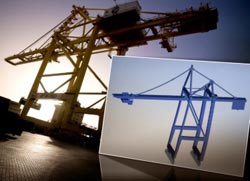Less Vibration of Cranes: Faster Loading of Ships

To restrict such motion, so that containers can be set down with an accuracy of a few centimeters, crane drivers have to reduce operating speed, which extends loading and unloading times. The active damper system from Siemens counteracts vibrations by moving a weight along the container bridge. This keeps the crane steady at faster operating speeds. Siemens plans to introduce the system on the market by mid-2011, together with a crane builder.
Today’s container cranes have to be over 30 meters high in order to accommodate large container ships. At the same time, however, they must take up as little dockside space as possible, so that port vehicles have enough room. Such a delicate construction is not sufficiently rigid to withstand the forces generated by a swinging container. This results in vibrations: The greater the speed at which the crane trolley transports the load along the container bridge, the more the structure vibrates. So-called “passive mass dampers,” which weigh as much as 60 tons, are usually used to quell the vibrations. Suspended like a pendulum, they absorb them with a damper system, such as a hydraulic cylinder.
By comparison, the active damping system from Siemens Drive Technologies functions in a much more precise way and is able to make do with one tenth of the weight. Sensors on the container bridge measure the crane’s vibrations and transmit this data to a linear motor’s control system. On the basis of this information, the linear motor moves a weight of only a few metric tons along the container bridge. By means of precise acceleration and braking of this motor, forces are applied to the crane. Special algorithms are used to control the movement of the linear motor in such a way that vibrations are rapidly and effectively neutralized.
The active damping system was originally developed for mechanical engineering applications, especially for machinery used to produce parts with very precise surface characteristics. The work must be performed at low speeds, however, due to machine vibrations, resulting in high costs. Analysis of the precise characteristics of these vibrations made it possible to devise algorithms for a machine control system that suppresses such shaking. This procedure is currently undergoing testing with pilot customers.
Media Contact
More Information:
http://www.siemens.com/innovationnewsAll latest news from the category: Transportation and Logistics
This field deals with all spatial and time-related activities involved in bridging the gap between goods and people, including their restructuring. This begins with the supplier and follows each stage of the operational value chain to product delivery and concludes with product disposal and recycling.
innovations-report provides informative reports and articles on such topics as traffic telematics, toll collection, traffic management systems, route planning, high-speed rail (Transrapid), traffic infrastructures, air safety, transport technologies, transport logistics, production logistics and mobility.
Newest articles

Trotting robots reveal emergence of animal gait transitions
A four-legged robot trained with machine learning by EPFL researchers has learned to avoid falls by spontaneously switching between walking, trotting, and pronking – a milestone for roboticists as well…

Innovation promises to prevent power pole-top fires
Engineers in Australia have found a new way to make power-pole insulators resistant to fire and electrical sparking, promising to prevent dangerous pole-top fires and reduce blackouts. Pole-top fires pose…

Possible alternative to antibiotics produced by bacteria
Antibacterial substance from staphylococci discovered with new mechanism of action against natural competitors. Many bacteria produce substances to gain an advantage over competitors in their highly competitive natural environment. Researchers…





















